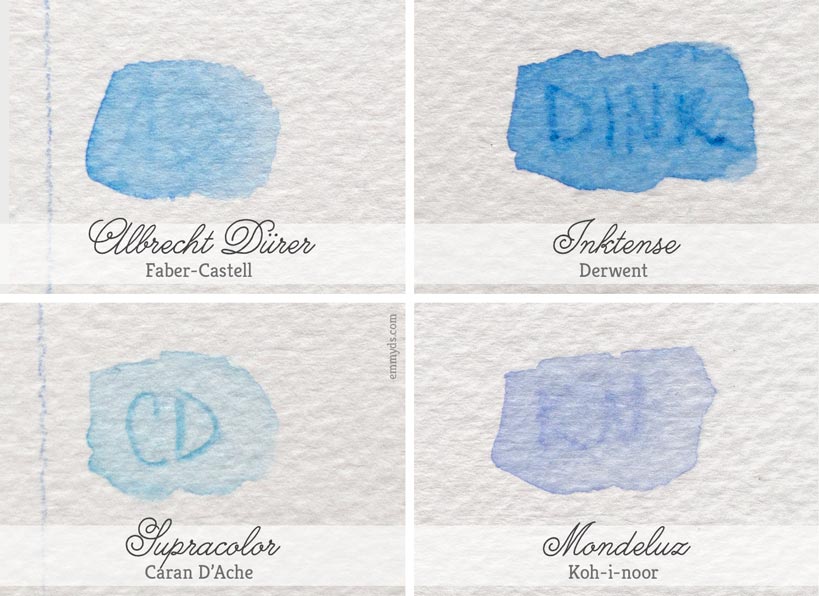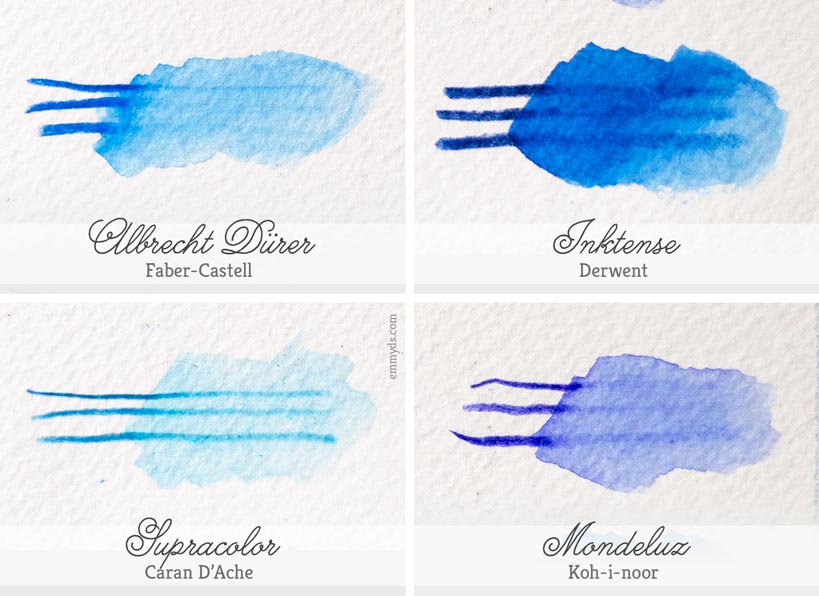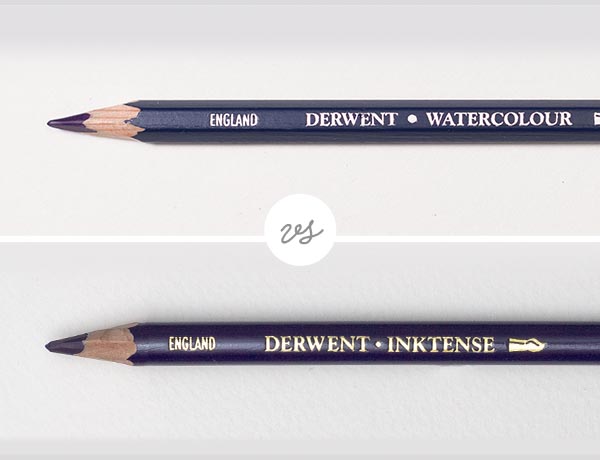When it comes to investing in art materials, many doubts arise related to brands and…
Watercolor Pencils Comparison (Faber-Castell vs. Derwent vs. Caran D’Ache vs. Koh-i-noor)
This article evaluates the main characteristics of four professional watercolor pencil brands. Initially, my plan was to test the same brands I tested while choosing my permanent colored pencil set (Faber-Castell, Derwent, and Prismacolor). However, I couldn’t find Prismacolor watercolor pencils anywhere nearby. Instead, I borrowed these from my drawing teacher, who generously lent me his pencils for testing: Faber-Castell’s Albrecht Dürer, Derwent’s Inktense, Caran D’Ache’s Supracolor, and Koh-i-noor’s Mondeluz.

What are watercolor pencils?
Watercolor pencils, unlike permanent ones, are water-soluble. They are not “watercolors in pencil form,” although some models promise to be like that (none on this list). However, some can mimic watercolors well, allowing the creation of washes and even functioning as watercolor chips. All the brands tested here are intended for professional use, and they promise complete stroke dilution by water (with proper paper).
Faber-Castell’s Albrecht Dürer
The professional watercolor line by Faber-Castell shares the same color chart as its permanent counterpart Polychromos. I couldn’t exclude them from this comparison since it’s a traditional and recognized brand, and easily accessible here in my country.

Albrecht Dürer specifications:
- Body Shape: hexagonal
- Lead: 3.8 mm
- Available in sets of 12, 24, 36, 60 and 120 colors.
- Available individually: yes
- Lightfastness rating: star system — ★★★ maximum / ★★ very good / ★ just ok
- Lightfastness: most of the colors are classified with 3 or 2 stars, some with one.
- Official Albrecht Dürer chart
Recently, this line received a “bigger brother” called Albrecht Dürer Magnus. They are the same Albrecht Dürer watercolor pencils but with 5.3 mm leads and, to date, with 30 colors available.
Derwent’s Inktense
The British Derwent has several lines of pencils with the water-solubility feature. The line I chose here is the professional one with soft lead: Inktense.
According to the manufacturer, these are their best watercolor pencils. They can be used in dry technique, but by mixing them with water they become vibrant ink. They are permanent after drying and therefore can be used in natural fabrics like cotton and silk — now I’m really curious to test this.

Inktense specifications:
- Body shape: rounded
- Lead: 4 mm
- Sets available: 6, 12, 18, 24, 36, 48 and 72 colors.
- Available individually: yes
- Lightfastness rating: Blue Wool scale (0 to 8) – 3,4: Acceptable / 5.6: good / 7.8: Excellent
- Lightfastness: vast majority of colors is classified into 7 or 8 , few in 2 to 4.
- Inktense official chart
Caran D’Ache’s Supracolor
The Swiss Caran d’Ache is one of the most traditional brands in colored pencil, has several lines, four of them water-soluble. For the consistency of this article, I will dwell on the line equivalent to the other brands reviewed here: professional use with water-soluble soft leads.
According to the manufacturer, the Supracolor line is ideal for dry technique as for washes. It’s ideal for covering large areas and has excellent lightfastness rates. It is also interesting to note that Supracolor prices (depending on your country) can be 60% higher than Albrecht Dürer ones, for example.

Supracolor Specifications:
- Body shape: hexagonal
- Lead: 3.8 mm, soft
- Available sets: 12, 18, 30, 40, 80 and 120 colors.
- Available individually: yes
- Lightfastness rating: star system — ★★★ maximum / ★★ very good / ok ★ only
- Official color chart: not found * (page does not exist through the link on the official page)
As I had access only to individual colors and did not find the official table to download, I was unable to verify the lightfastness rating of this line as a whole.
Koh-i-Noor’s Mondeluz
Mondeluz is the most accessible (in terms of price) in this list, but also, as well as Inktense, with only 72 colors available. Made with high-quality and highly concentrated pigments, contains white clay in its composition (which, according to the manufacturer, gives it “an unsurpassable ability to make a unique stroke on the paper or other medium”, whatever that’s supposed to mean). Also, the brand ensures the excellent solubility of all the components.

Mondeluz specifications:
- Body shape: hexagonal
- Lead: 3.8 mm
- Available sets: 12, 24, 36, 48 and 72
- Available individually: I did not found, although it is known they are sold somewhere in the world.
- Lightfastness rating: star system, 1 to 4 — ★★★★ maximum / ★★★ very good / ★★ good / ★ acceptable
- Lightfastness: most colors are rated with 3 or 4 stars; only 4 colors classified with one.
- Mondeluz official chart
Tests
Here there are my tests with each of these pencils, comparing them. The paper I used was Canson Montval with fine texture.
Firstly, dry strokes. Painting with maximum pressure up to light pressure, all delivered very similar results. They are all really soft. Although Inktense is a little softer and hence releases more “dust” while painting with highest pressure (these pieces that are around the paintings are pieces of leads). Supracolor was the one which released less of those particles.

For the wash, I tried to verify the following: strokes solubility, the ease of working with the ink that comes from strokes, the intensity of color. Undoubtedly, Inktense is the most pigmented. By passing the brush with water, the amount of ink that comes from strokes is remarkable.

When washing a very saturated area, all of them had similar results after drying. But to be sure of the complete solubility of strokes, I did the following test: drew small, medium pressure strokes and applied the brush with water. The result, after drying, was as follows:

To ensure this result, I repeated the test. This time, I traced with maximum pressure but insisted with the brush to force the lines to dissolve completely — or as much as possible. The result was as follows:

Conclusion
The four brands, as with all professional art supplies, have their pros and cons. Here a few things that I believe should be taken into consideration while choosing among them.
- Preferred application: If you prefer dry technique, wash, or both. If you want more defined strokes and yet the possibility to create watercolors, Supracolor would be a good choice. If your preference is watercolor, large areas of coverage and intense colors, Inktense will do an excellent job. If you want to use your pencils as if they were watercolors at some point — preparing leads separately and use them as watercolor chips — you should choose the ones that dissolve completely, as Albrecht Dürer or Inktense.
- Your goals with this material: if you will sell your originals then is extremely important to pay attention to the lightfastness of the materials used. That’s why I like to check all official color charts, so I know what are the safest colors (even before investing in the set) to use in paintings that should last for many years.
- Use in mixed media technique: if you already use any professional line of some of these brands, and is keen to have the same color in different materials, give preference to the brand you already use. They usually have the same color chart.
- Price and accessibility of new items: important to note that in this comparison I did not consider prices, but some things in this list can cost twice as others, then always research. In some countries, like Brazil, it is still very difficult to get replacement for Mondeluz and Supracolor, for example. Please note that some of your colors (the ones you use most) will get used very quickly, therefore to be able to replace them with ease is something to consider.
Sources for this article: Faber-Castell, Derwent, Caran D’Ache, Koh-i-noor, Coloured Pencil Topics.
This Post Has 15 Comments
Comments are closed.

Parabéns pela matéria. Consegui achar o lápis mondeluz avulso na loja Boutique do Papel, no shopping Rio Sul (RJ).
Thank you for this comparison! I was really having a tough time deciding which ones to buy.
Thank you for your comment! I’m really happy I could help ^_^
Thanks for this!! Thinking of switching from my Caran d’ache to faber castell or inktense, as I don’t really like that CD doesnt dissolve well.
Do you also do watercolour? If so, would you consider doing something similar to this for the most popular brands? I want to start it, but am unsure of which brand to go for.
Thank you!!
Hi Wil, thank you for your comment! That’s a good idea actually. We do watercolor, yes. I started with Cotman and my sister uses Van Gogh. I’d need to find out one or two other popular student level brands for a good comparison. If you have any suggestion feel free to write here ^_^ Warm regards,🦉
O mondeluz tem avulso na koralle e tbm o lápis progresso integral que parece ser interessante, quando fui na koralle pegar uns materiais quase peguei um inktense avulso, mas aí não ia dar na cota, vai ter que ficar pra próxima vez.
Oi, Laura! Muito obrigada pelo comentário. Já faz algum tempo que escrevi essa resenha, na próxima revisão, vou atualizar este item! Um grande abraço ^_^, 🦉
Ótima resenha! Você já testou o lápis de cor aquarela profissional da Compactor? Pesquisando sobre lápis aquareláveis encontrei esse com ótimo preço (cerca de 200 reais a caixa com 48 cores), que a marca relata ser de uso profissional.
Oi, Elisane! Obrigada pelo comentário! Ainda não tivemos a oportunidade de testar. Caso pense em investir, por ser voltada para profissionais, a marca deve indicar a durabilidade e resistência das cores, o que é um ponto importante a se observar. Caso tenha a oportunidade de testar e quiser compartilhar conosco suas impressões, vamos amar ☺ Um abraço, 🦉
Justamente, enviei email pedindo a tabela de cores com a permanência e resistência à luz.. Não resisti e já comprei amtes de ter essa resposta, mas quero essa tabela. Assim que tiver todas as informações vou testar e te falo. Fico surpresa em ver uma marca brasileira desenvolver um produto de qualidade artística aqui, tomara que seja mesmo. Afinal estamos acostumadas a comprar as linhas profissionais importadas, o que aumenta demais o preço e também torna mais difícil encontrar nas lojas. Vendo sua resenha aqui tinha decididp completar minhas cores com o Albrecht Durer, mas achei essa caixa com 48 cores e os.olhos brilharam igual criança rsrsr
Realmente, espero que seja! Vamos adorar receber seu parecer. Quem sabe, também vamos atrás para uma resenha completa. Um material desses de produção nacional realmente seria muito bem vindo! Dedos cruzados para que sejam ótimos 🙏 Um grande abraço, ☺🦉
Pedi informações a empresa mas só me enviaram uma lista com os nomes em inglês e códigos de cada cor, o que me fez procurar na internet – descobri (pelos códigos e design na caixa) que são fabricados na China, com a marca “Marco Renoir, e que são também os mesmos lápis aquarelaveis vendidos pela Bruynzeel, da linha “Bruynzeel Design”, mas com embalagem reformulada (sendo que este último custa 500 reais na Companhia do Papel). Apesar de produzidos na China, as resenhas destes lápis (Marco Renoir e Bruynzeel aquarelaveis) são muito boas. Os meus da Compactor chegaram e até agora gostei – diluem bem e a cor ativa muito bem ao diluir. Uma pena não fornecerem a resistência à luz. Vou usar para desenhos que vou digitalizar, aí não corro risco. Fiz um chart, deixei na janela e vou esperar uns meses para checar.
Nossa, muito interessante. Há muito tempo também já testei alguns lápis da Bruynzeel – mas na época eram tão difíceis de encontrar que não me aprofundei nos testes com ele. Mas a informação que descobriu é muito relevante. E esse teste caseiro de resistência à luz já vai ajudar a saber se você pode vender os originais com segurança ou não. Uma coisa que vi uma vez (e que fiz com umas aquarelas chinesas que eu tinha aqui) é colocar o chart na janela bem como você fez, com metade de cada cor coberta por um papel preto. Depois de vários dias de sol forte, vai ser possível notar a diferença entre o coberto e o exposto caso o pigmento não seja tão resistente.
Fiz isso, tampei parcialmente com um papel preto, vou esperar um tempo para ver (um especialista americano no assunto me disse que o ideal é esperar 9 meses, mas sei que as cores mais fugidias empalidecem antes). Estes dias a Compactor acabou me enviando uma tabela de resistência das cores destes lápis. Os violetas e rosas são os menos resistentes (tende a ser um problema maior desses pigmentos mesmo).
Sim…! São exatamente os pigmentos que normalmente resistem menos. Muito bom que eles enviaram a tabela, essas informações são de extrema importância na criação de pinturas originais. E se acontecer de a durabilidade dessas cores que mencionou ser muito baixa, pode substituir apenas essas por avulsos de outra marca que tenham mais ou menos as mesmas características ao utilizar (solubilidade, resistência da mina, etc.). Muito obrigada por compartilhar a sua experiência! 😊🦉